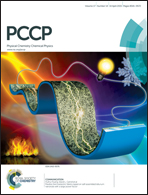Excitation and quenching mechanisms in the near-UV photodissociation of CH3Br and CH3Cl adsorbed on D2O or CH3OH on Cu(110)
Abstract
Photochemical processes for CH3X (X = Cl, Br, I) adsorbed on top of thin films of D2O or CH3OH on a Cu(110) substrate is studied by time-of-flight mass spectrometry for a range of UV wavelengths (351–193 nm). Photodissociation via dissociative electron attachment by photoelectrons and by neutral photodissociation is identified and quantified based on the observed dynamics of the desorbing CH3 fragments. Photoelectron-driven dissociation of CH3X is found to be a maximum for monolayer quantities of the D2O or CH3OH on Cu(110), but with differing kinetic energy release on the two substrates. The dynamics of CH3Br and CH3Cl photodissociation qualitatively differ on CH3OH/Cu(110) as compared to D2O/Cu(110), which is ascribed to differing molecular structures for these systems. Evidence is presented for an efficient inter-molecular quenching mechanism for neutral photoexcitation of CH3Cl and CH3Br on the CH3OH/Cu(110) substrate.


 Please wait while we load your content...
Please wait while we load your content...